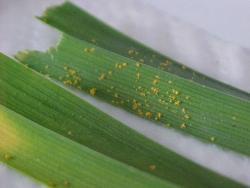This diagram and explanation from my rust site may be of interest:
http://web.ncf.ca/ah748/diagra...
Quoting also from:
Brand A, Gow NA. Mechanisms of hypha orientation of fungi. Current Opinion in Microbiology. 2009;12(4):350-357. doi:10.1016/j.mib.2009.05.007.
"Uromyces and
Puccinia species and many other plant pathogens gain access to the plant by forming appressoria over the guard cells of stoma. The germ tubes of these fungi exhibit contact sensing and orientation in relation to the topography of the epithelial substratum (thigmotropism). Initially, hyphae grow perpendicularly across the plane of axis of the epithelial cells — a strategy that is thought to aid the location of stoma, which in monocotyledons are often positioned in staggered rows. When the germ tube encounters a guard cell of a specific lip height, an appressorium is induced (thigmodifferentiation) [23]. Elegant experiments with chemically inert plastic replica surfaces demonstrated that these events are mediated entirely by the topography of the plant surface and not by any chemical gradients."
Years ago when I had some rust with which to experiment I did some leaf segment tests. The picture below shows a leaf segment that was exposed to daylily rust spores
after being cut.

There are no pustules close to the cut surface. One could argue, I suppose, that I might not have exposed that part to spores but if you look at Figure 2, page 49 of this daylily rust research (incidentally also the one that first indicated dishwashing liquid had some benefit in rust control) there are no pustules near the cut surface as one would expect if that was a point of entry:
http://www.uoguelph.ca/%7Ethsi...
The cut surface would not have the topography that the germ tubes would be seeking so I can't see this as being a major infection point if it ever is at all.
Edited to add a quote specific to daylily rust:
".......germinating urediniospores produced germ tubes on the leaf surface within 24 hr. Each urediniospore formed one germ tube. Germ tubes stopped elongating at stomata, formed oblong appressoria that took the shape of the stomata, and often had a collapsed appearance. The infection peg, which originated from the appressorium, penetrated through the stomal opening and formed a spherical substomatal vesicle in the substomatal space from which intercellular hyphae were differentiated........."
This is from Li, YH, Windham MT, Trigiano RN , Fare DC. 2007. Microscopic and macroscopic studies of the development of Puccinia hemerocallidis in resistant and susceptible daylily cultivars. Am Phytopath Society.
Edited to correct broken link:
http://apsjournals.apsnet.org/...
